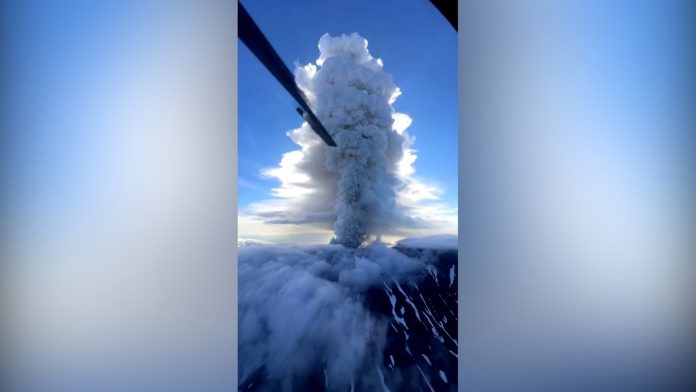A Sleepy Giant Awakens: The Krasheninnikov Volcano Erupts After Six Centuries
Deep within the wild and rugged expanse of Russia’s far-east Kamchatka Peninsula, a volcanic titan has stirred from a 600-year slumber. The Krasheninnikov Volcano, dormant for centuries, has shattered silence with a spectacular eruption—reminding the world that nature’s patience can run out in the blink of an eye.
Imagine standing in the shadow of a mountain that has not breathed fire since before the Renaissance dawned in Europe. It’s almost unfathomable. Yet, here it is—a plume of ash billowing skyward, piercing the heavens with its charcoal smoke, marking the rebirth of this striking geological monument. The Kamchatka Peninsula, a region long admired by adventurous travelers and volcanologists alike for its otherworldly landscapes, is suddenly the epicenter of global attention.
Kamchatka: A Land of Fire and Ice
The peninsula itself is a land of stark contrasts—towering volcanic peaks, steaming geysers, and icy glaciers. Dubbed the “Land of Fire and Ice,” Kamchatka is home to over 300 volcanoes, 29 of them active, and harboring some of the most dramatic volcanic activity on Earth. Local Kamchatkans have lived with the moods of these volcanoes for generations, coexisting in a delicate dance with nature’s potential fury.
Sergei Ivanov, a geologist who has studied Kamchatka’s volcanoes for over 20 years, shared his perspective: “The eruption of Krasheninnikov is a powerful reminder of the dynamic forces beneath our feet. Volcanoes here don’t just shape the landscape; they shape the lives and culture of the people. For centuries, Krasheninnikov slept peacefully, but the Earth never forgets.”
The Eruption: A Monumental Event
On a sobering Wednesday morning, seismic monitors detected tremors across the peninsula. Moments later, the sky was rent by a towering ash cloud rising approximately 6,000 meters (close to 20,000 feet). For context, this is higher than many commercial airplanes fly—an ash plume of such magnitude poses serious threats to aviation, public health, and nearby communities.
Standing at 1,856 meters tall, the Krasheninnikov Volcano’s eruption sent shockwaves far beyond Kamchatka. The region was already on edge, grappling with the impact of a colossal 8.8-magnitude earthquake that reverberated through the area, sending tsunami warnings all the way to distant shores in French Polynesia and Chile. The timing was grim—a violent shake followed by fire from below, nature’s tumultuous symphony.
“It’s a rare phenomenon,” noted Anna Petrovna, a volcanologist based in Moscow. “A volcano lying dormant for centuries doesn’t simply vanish; it often leaves clues. This awakening could be the start of a longer eruptive phase. We’re watching closely.”
What This Means for Local Communities
Kamchatka’s small towns and indigenous communities have always lived on the edge of disaster. Ash fall can contaminate water supplies, destroy crops, and cripple transportation. The last time Krasheninnikov erupted, the world looked profoundly different—before electric grids, air travel, or instantaneous global communication.
Transitioning from awe to concern, locals are adapting swiftly. Emergency services, coordinated by Russia’s Ministry for Emergency Situations, have been mobilized. Evacuations and precautionary measures are in place, but the remoteness and ruggedness of Kamchatka complicate relief efforts. Roads are few and often treacherous, especially under a cover of ash and smoke.
Yelena Kostina, a resident of a nearby village, spoke candidly: “When the ground shakes and the sky turns dark, you remember how fragile life is. Yet, we have learned to respect the land—and each other. This eruption is frightening, yes, but it’s also part of our story.”
Understanding the Volcanic Awakening in a Global Context
The Krasheninnikov eruption is more than a local emergency; it is a potent symbol of our planet’s restless forces. Each volcanic event offers a lesson about resilience and vulnerability, and it invites reflection on humanity’s impact and relationship with the environment.
In recent years, science has made strides in predicting such eruptions. Satellite imagery, seismic networks, and ash dispersion models help nations prepare better. Yet, as Kamchatka shows, even those with advanced technology are often humbled by nature’s unpredictability.
For the broader world, this event prompts questions: How prepared are we for the unexpected—whether natural disasters or climate change? How can remote communities gain better support amidst global crises? As the ash drifts across skies and settles quietly in forests, it writes a reminder on the pages of history.
The Poetry of Ash and Stone
Walking through the Kamchatkan wilderness today is to walk among the scars and hopes of millennia. The eruption, while destructive, also revitalizes—bringing nutrients to soils and reshaping landscapes. Volcanoes are paradoxical: creators and destroyers, destroyers and creators.
As the volcano exhales smoke and ash into the cold, endless sky, it tells its story—one of deep time and primal power. For those watching—scientists, locals, and distant global watchers alike—it is a story filled with beauty and warning.
So, what does Krasheninnikov’s fiery return mean to you? Does it awaken a sense of nature’s power? Stir an appreciation for our planet’s volatility? Or perhaps, it reminds us all of our place in the great unfolding drama of Earth’s history.
In a world where the fast pace of life often disconnects us from the wild, moments like these call us back—to observe, to listen, and above all, to remember that the Earth is alive, restless, and ever-changing.
Looking Ahead
Scientists will keep a close watch on Krasheninnikov’s activity, sharing updates as they unfold. For now, the focus remains on safety, resilience, and community strength amid adversity. And across the globe, we are reminded that even the most silent giants may awake when least expected.
From the frozen wilds of Kamchatka to every corner of our interconnected world, the Earth whispers. Will we listen?





